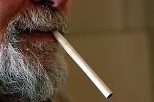The risk of lung cancer is no different in people who smoke medium-tar, low-tar or very low-tar cigarettes, concludes a study by an MIT-led research team published Jan. 10 in the British Medical Journal (BMJ).
The study, led by Jeffrey E. Harris, professor in the economics department and in the Harvard-MIT Division of Health Sciences and Technology, is the first to compare lung cancer risk between smokers of reduced-tar and conventional cigarettes. It found that reduced-tar cigarettes do not reduce the risk of lung cancer.
"As a practicing physician, I would advise a smoking patient that there is no known benefit if you switch from a regular filter brand to a low-tar or ultra low-tar brand, and that the only proven way to reduce risk is to quit as soon as possible," Harris said.
Researchers analyzed the relation between the tar rating of the brand of cigarette smoked in 1982 and death from lung cancer over six years among 364,239 men and 576,535 women aged 30 years or more.
Men and women who smoked very low-tar (7 mg or less) and low-tar (8-14 mg) brands had risks of lung cancer indistinguishable from those who smoked medium-tar (15-21 mg) brands. This pattern did not change after demographic factors, dietary habits, and occupational and medical histories were taken into account.
Harris teaches health economics and health policy at MIT and is a primary care physician at Massachusetts General Hospital. Co-authors are Michael J. Thun, vice president of epidemiology and surveillance research for the American Cancer Society, and Jeanne Calle, ACS director of analytical epidemiology.
In the 1970s, governments, health officials and the public were convinced that reducing the tar levels in cigarette smoke would make cigarettes somewhat safer. A standard test was developed to measure the tar and nicotine content.
According to the BMJ study, regardless of the tar level of their current brand, all smokers had a far greater risk of lung cancer than people who had never smoked or who had quit. Those who smoked nonfiltered cigarettes with tar ratings of 22 mg or more had the highest risk of lung cancer.
These findings are consistent with the conclusions of the National Cancer Institute, which recently determined there is no reliable evidence that lung cancer risk is reduced by decreasing the machine-measured tar level in cigarettes. "As a member of the public health community, I would suggest that we rethink our current system of rating cigarettes according to machine-measured tar deliveries," Harris said.
Other studies have shown that people smoke low-tar cigarettes more intensively, calling into question the assumption that tar rating and lung cancer risk are linked, say the authors.
They suggest that reducing the use of high-tar, nonfiltered cigarettes may provide limited public health benefits in those countries where these products are commonly used.
A version of this article appeared in MIT Tech Talk on January 14, 2004.






